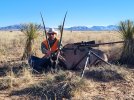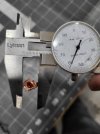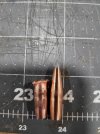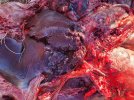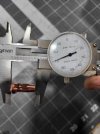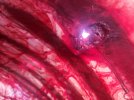I had a successful Oryx hunt on Friday. I ended up harvesting a 38.5"x39.5" cow on the first day. It was a great time and good memories made with my 12-year-old son and longtime best hunting buddy. The shot was 580 yards on the nose, my dope was spot on as the bullet impacted exactly where I intended vertically. The bullet did impact a little further back than I wanted. There was a puff of wind, 3-5 mph, so I either pulled the shot a little, wind barely got me or a combination of both. If you zoom in to the picture with the oryx, you can see the impact. I have attached several photographs; they are not in order of the story, but you can go look at them as you read.
So you don't have to go back, the rifle is a 308 Winchester 26" barrel, 150 BD 2, 47.7 grains LVR powder, 3037 fps. The gun is shooting an honest 3/4 MOA at 600 yards.
The bullet entered the left side, behind the shoulder. You can see the impact in the picture. It is in the crease of the front shoulder where the blood is. Disregard the blood on top of her back, that is where she flung her head and blood landed there. The bullet did impact a rib on the way in. If you look at the picture of the inside of the rib, it appears the bullet started too immediately open, or some rib bone tore that flesh. The diameter of the wound was greater than a 1/2". From what I can tell, between the petals and the shank of the bullet, the lungs and liver were the vital organs that caught most of the damage caused by the bullet. You can tell in the pictures that both were impacted pretty severely. I was unable to locate any of petals but did find the shank of the bullet resting on the far side just under the ribs. The bullet did not penetrate into the far side ribs. The bullet did open to a diameter of .459" and lost 3 of the 4 petals completely. You can see one of the photos, a partial petal is still attached to bullet. This petal did lose a significant amount of its overall length, but the base stayed intact. The bullet ended up with an overall length of .871" from its original length of 1.385".
The shot and animal behavior after impact:
As said before, the shot was 580 yards. I was kneeling off of a RRS tripod. Grass is tall this year, you'd have to get pretty good elevation to go prone, I never even attached my bipod. The good thing about a 308 shooting a 150-grain bullet is the recoil, or lack thereof. Off of my tripod I was able to watch the initial reactions of the oryx when the bullet impacted. Her front legs buckled, and she kicked her back legs like a mule then took off fairly quickly. My buddy, son nor I ever heard an audible "whoop" of the bullet when it impacted. I am not sure if this always common with copper bullets or an anomaly. I had a real hard time hearing them impact steel as well if you go back and read my other post. So, the oryx took off, ran about 75 yards and bedded down, not went down, bedded down. We watched her for a bit then she stood back up and wandered another 75 or so yards and stopped. At this point she was around 700 yards. I had full intentions of only shooting this combo a max of 500 yards but built my dope card to 600, just in case, and didn't have any dopes for 700 with me. I had my kestrel in my truck so no luck there either. I did not get another shot but she did bed down again. My buddy stayed behind and my son and I walked closer. My buddy that stayed behind was able to walk us in to where she was located. We got to about 100 yards of the oryx and noticed she still had her head up but was really wobbly. I went ahead and put another bullet in her. With the grass being tall and me being afraid to shoot grass, I held too high and actually shot her through the hump or those familiar with oryx, known as no man's land. There is nothing up there vital. The oryx did expire fairly quickly after this shot, but looking at the damage, it probably did not contribute much to her death. The first shot had done its job, it was just not immediate. The second bullet was a pass through, and the exit can actually be seen in the photograph if you look just under the buttstock on my rifle.
Overall impressions:
This is a sample of one so I cannot say definitively until I put some more bullets on critters. May have a chance for them to harvest some ewe barbary sheep in February so that may give more results. Overall, I was quite happy with the way they shot and they way they performed. I am extremely happy with LVR and the 308 Winchester velocities. I am not getting into the debates that have happened in this thread but if you want more velocity in your 308 it's worth a look. I would have like to have hit this oryx on the shoulder and see what the bullet would have done, but the petals coming off definitely helped by causing trauma to the liver and the lungs. I was happy to see that the bullet started to open as soon as it did. I have never worried about penetration with an all-copper bullet but have had my worries about the ability to expand. It seems this bullet did both pretty well. I would have thought it would have penetrated the opposite side rib cage, but bullets do weird things so who knows why it didn't. My kestrel says at 580 yards, I had 2186 fps and 1592 ft lbs of energy when that bullet reached its intended target. I will definitely shoot more critters with this bullet and will probably start loading it for my daughters 308. I would not be afraid to use this combination out to 500 yards on anything I hunt in NM. I may give the 175 a whirl in my 300 wsm. From my sample of one, I will continue to use them.
NRAlifer- thanks for sharing your knowledge and what you have learned from LVR and the 308. I would not have tried it had you not posted what you guys were finding. I would have just shot this oryx with the boring accurate combo of a 300 wsm and 175 berger vld. Thanks!


